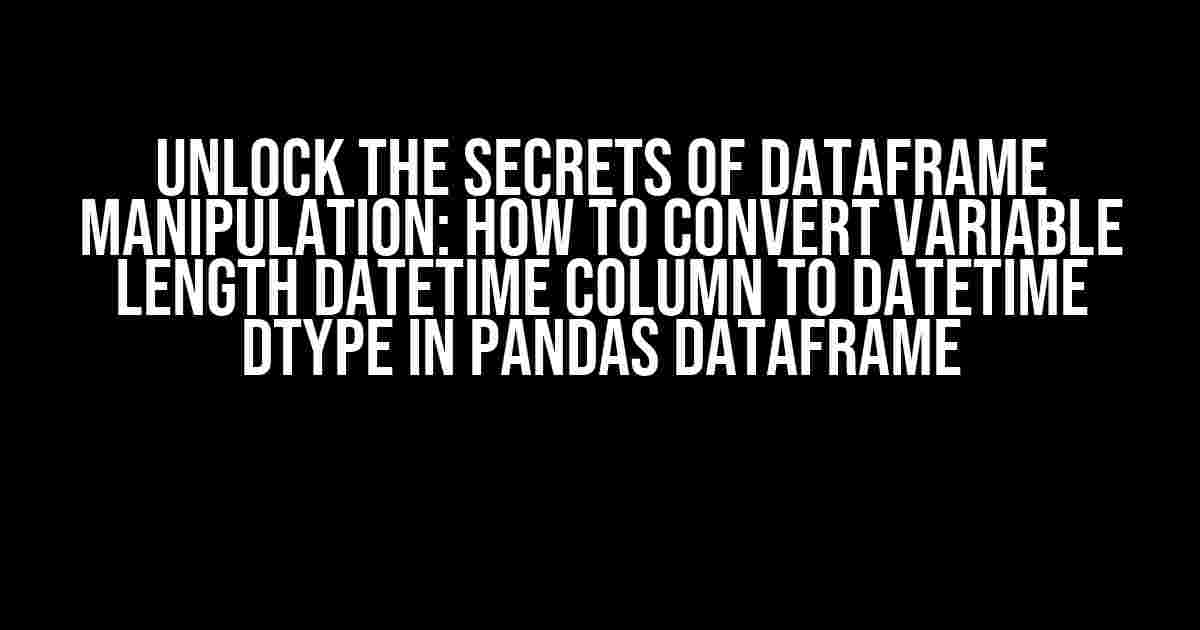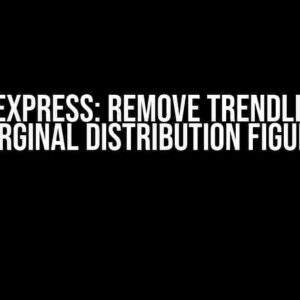Ah, the joys of working with datasets in pandas! Sometimes, however, the excitement can quickly turn into frustration when dealing with datetime columns that just won’t cooperate. Specifically, when your datetime column has variable lengths, it can be a real headache to convert it to the datetime dtype in your pandas DataFrame. Fear not, dear data wrangler, for we’re about to embark on a journey to tame this beast and emerge victorious!
The Problem: Variable Length Datetime Column
Imagine you’ve got a DataFrame with a column that’s supposed to contain dates in a specific format, but due to some data manipulation or import issues, the format is all over the place. You’ve got dates in the format ‘YYYY-MM-DD’, ‘DD/MM/YYYY’, ‘MM/DD/YYYY’, and even some weird ones like ‘DD MMM YYYY’. How do you convert this column into a datetime dtype, which is essential for any sort of date-based analysis or processing?
That’s where the `pd.to_datetime()` function comes in, but as you might have discovered, it’s not as straightforward as it seems. By default, `pd.to_datetime()` expects a specific format, and if your column doesn’t conform to that format, you’ll end up with a bunch of `NaT` (Not a Time) values or worse – errors!
Understanding the pd.to_datetime() Function
Before we dive into the solution, let’s take a closer look at the `pd.to_datetime()` function. This powerful function can convert a variety of date-like objects into a datetime dtype. It takes several parameters, including:
arg: The column or data to be converted.errors: How to handle parsing errors (default is ‘raise’).format: The expected format of the date strings.utc: Whether to interpret the dates as UTC or not.box: Whether to return a pandas TIMESTAMP object or not.
By default, `pd.to_datetime()` is quite strict when it comes to the format of the input data. If your column contains dates in different formats, you’ll need to specify the exact format using the `format` parameter. But what if you don’t know the format in advance or have multiple formats mixed together?
The Solution: Using the `pd.to_datetime()` with `errors=’coerce’` and `format=None`
Here’s the trick: set the `errors` parameter to `’coerce’` and the `format` parameter to `None`. This tells `pd.to_datetime()` to:
- Attempt to parse the date strings in the column using a variety of formats (this is where the magic happens!).
- If a date string can’t be parsed, replace it with a `NaT` value instead of raising an error.
import pandas as pd
# sample DataFrame with variable length datetime column
df = pd.DataFrame({'date_col': ['2022-01-01', '31/12/2021', '2021-02-28 14:30:00', 'Invalid Date']})
# convert the column to datetime dtype using pd.to_datetime()
df['date_col'] = pd.to_datetime(df['date_col'], errors='coerce', format=None)
print(df)
| date_col |
|---|
| 2022-01-01 00:00:00 |
| 2021-12-31 00:00:00 |
| 2021-02-28 14:30:00 |
| NaT |
Voilà! The resulting DataFrame has the `date_col` converted to datetime dtype, with the invalid date string replaced by a `NaT` value.
Handling Multiple Formats and Edge Cases
But what about those pesky edge cases, like dates with different delimiters or formats? Fear not, for we’ve got some additional tricks up our sleeve:
Using a Custom Date Parser
When dealing with dates in different formats, you can create a custom date parser using a lambda function. This allows you to specify multiple formats and handle edge cases:
import pandas as pd
# sample DataFrame with variable length datetime column
df = pd.DataFrame({'date_col': ['2022-01-01', '31/12/2021', '2021-02-28 14:30:00', 'Invalid Date']})
# define a custom date parser
def parse_dates(date_string):
formats = ['%Y-%m-%d', '%d/%m/%Y', '%Y-%m-%d %H:%M:%S']
for fmt in formats:
try:
return pd.to_datetime(date_string, format=fmt)
except ValueError:
pass
return pd.NaT
# apply the custom date parser to the column
df['date_col'] = df['date_col'].apply(parse_dates)
print(df)
This custom parser will attempt to parse the date strings using multiple formats and return a `NaT` value if none of the formats match.
Using the `dateutil` Library
Another approach is to use the `dateutil` library, which provides a powerful parser that can handle a wide range of date formats:
import pandas as pd
from dateutil import parser
# sample DataFrame with variable length datetime column
df = pd.DataFrame({'date_col': ['2022-01-01', '31/12/2021', '2021-02-28 14:30:00', 'Invalid Date']})
# apply the dateutil parser to the column
df['date_col'] = df['date_col'].apply(parser.parse)
print(df)
The `dateutil` parser is quite flexible and can handle many different date formats, including those with varying delimiters and ordering.
Conclusion
And there you have it, folks! With these techniques, you should be able to convert even the most unruly datetime columns to a datetime dtype in your pandas DataFrame. Remember to experiment with different approaches, as the best method will depend on the specific characteristics of your dataset.
By mastering the art of datetime column manipulation, you’ll unlock a world of possibilities for data analysis and processing. Happy coding, and remember to keep those dates in line!
Keywords: pandas, datetime, dataframe, pd.to_datetime(), variable length, format, errors=’coerce’, format=None, dateutil, parser, lambda function, custom date parser, edge cases, data manipulation, data analysis.
Frequently Asked Question
When working with datetime columns in pandas, it’s not uncommon to encounter variable length datetime columns. But, how do you convert them to a datetime dtype? Let’s dive in and find out!
Q1: What’s the simplest way to convert a variable length datetime column to datetime dtype in pandas?
You can use the `pd.to_datetime()` function with the `errors=’coerce’` parameter! This will convert the column to datetime dtype, and any invalid values will be replaced with `NaT` (Not a Time).
Q2: What if I have a column with mixed datetime formats? How do I convert it to a single datetime format?
In this case, you can use the `pd.to_datetime()` function with the `format` parameter. Specify the format of the datetime column using the `format` parameter, and pandas will take care of the rest!
Q3: How do I handle datetime columns with timezone information?
No problem! When converting a datetime column with timezone information, you can use the `pd.to_datetime()` function with the `utc` parameter set to `True`. This will convert the column to UTC timezone.
Q4: What if I have a column with dates in string format, but with inconsistent formatting? How do I convert it to datetime dtype?
In this case, you can use the `dateutil.parser` library to parse the dates. Then, use the `pd.to_datetime()` function to convert the parsed dates to datetime dtype.
Q5: Can I convert a column with datetime strings in a non-standard format to datetime dtype?
Yes, you can! Use the `pd.to_datetime()` function with the `format` parameter to specify the non-standard format. Pandas will take care of the rest!



